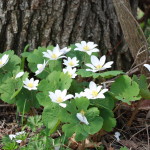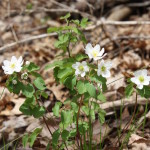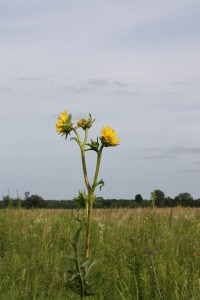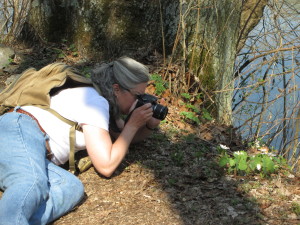Any naturalist afoot in Wisconsin this month is looking for wildflowers and finding plenty. Every week brings another “birthday,” as Aldo Leopold called a species’ first blossoming of the year. Along the Baraboo River, I can look forward to a changing array of woodland, wetland, and prairie plants flowering from spring through summer.
And this spring and summer, as I do every year, I will look up and try to memorize the names of all the plants I don’t yet know. Even as my list of familiar plants grows longer, I know that the list of unknowns will continue to stretch before me, and I will spend many an hour muddying my knees to inspect stems, count petals, and sketch leaves.
Why so much effort? Certainly it’s possible to enjoy the beauty of wildflowers without troubling to learn all their names. But for most naturalists, this is trouble of the best kind. Some people value the sense of mastery that comes with knowing and being able to identify the plants and animals in their midst. Others experience a greater sense of community – as we do in our own human communities – through knowing the names of their neighbors.
A shared nomenclature is of course essential to record-keeping and scientific knowledge. For example, my phenology calendar gives May 12 as the “birthday” on which yarrow begins to bloom. This bit of intelligence is only possible because observers, over the years, recorded “yarrow,” rather than “small white flower” in their field notes.
The same goes for storytelling. Aldo Leopold wrote in A Sand County Almanac of a solitary compass plant – a lonely holdout from our region’s tallgrass prairie days – that he found blooming each July, until one year when the county road department finally mowed it down. Leopold briefly describes the compass plant, and for a reader who’s never seen one, his description may suffice. But to those who know precisely what a compass plant is and can picture it, Leopold’s last soldier is more than just a plant with “saucer-sized yellow blooms resembling sunflowers.” Instead, it has become an emblem of the lost prairies.
My own interest in plant names began many years ago on a walk near St. John’s, Newfoundland. I was with my uncle, Charlie Horwood, a respected Newfoundland naturalist, and we were roaming a family-owned woodlot. I’d seen several clumps of a low plant with white flowers and asked, casually, “What’s this?” I expected an equally casual response, but instead he knelt, said, “Let’s see,” and plucked one of the plants at the base of the stem. Back in town, he pulled books from the shelves and showed me how to compare the flowers, stem, and leaves with those in the illustrations, and thus identify the three-toothed cinquefoil (I suspect he already knew what it was).
As I learned the common and scientific names of more Newfoundland wildflowers, I realized that I could recognize members of the same families, and even the same genuses, in Wisconsin by spotting shared characteristics. (Here in Wisconsin, we have laurels, mints, buttercups, and members of other families that are similar to those in Newfoundland.)
Even far from home – in Colorado, West Virginia, wherever – I can look at a plant’s characteristics and make connections: this one has leaves like a geranium; the flowers of that one look like a member of the mustard family. Patterns emerge, and connections become visible across regions and from one ecosystem to the next.
The more I know, the more the natural world seems like an intricate and beautiful puzzle – a puzzle that becomes more fabulous with each new discovery. For knowledge like that, I’m willing to spend considerable time in the dust, on my knees.




